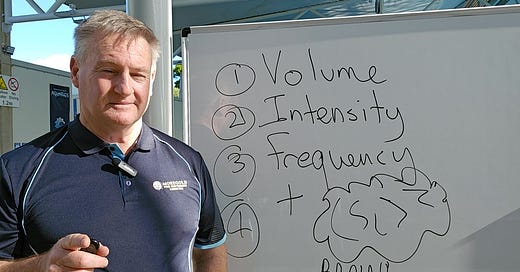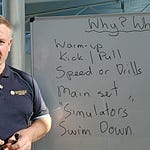By Wayne Goldsmith
Three Key Concepts:
Most coaches obsess over volume, intensity, and frequency while completely ignoring the brain
Mental skills training must be integrated into every workout, not treated as an optional add-on
The fourth variable—training the brain—often determines who reaches their potential and who doesn't
Every coaching textbook teaches the same three variables: Volume (how much), Intensity (how hard), Frequency (how often). Walk into any pool and you'll hear coaches discussing meters per week, lactate threshold sets and training sessions per day.
But here's what's missing from 95% of workout plans worldwide: training the brain.
I've spent three decades watching coaches meticulously plan every physiological detail of their sessions—calculating precise rest intervals, monitoring heart rates, periodizing training loads—while completely ignoring the most powerful performance variable of all: the space between their swimmers' ears.
Think about your last workout. Did you plan how to challenge your swimmers' mental resilience? Did you include exercises to improve their focus under pressure? Did you design opportunities to practice emotional control when fatigue sets in? Or did you just write "8 x 100 on 1:20" and call it coaching?
The swimmers who reach the podium at major championships aren't just physiologically superior—they're mentally trained. They've practiced staying calm when their race plan falls apart. They've rehearsed positive self-talk when lactate floods their system. They've trained their brains to make smart tactical decisions when oxygen debt clouds their thinking.
Yet most coaches treat mental skills like an afterthought. "We'll do some visualization next week." "I should probably talk to them about goal setting sometime." Meanwhile, they spend hours calculating training zones and periodization charts.
Here's the reality: Volume, Intensity, and Frequency without Brain training creates fast practice swimmers who crumble under competition pressure. But when you integrate mental skills into every session—when you make brain training as systematic as your lactate sets—you develop complete swimmers who perform when it matters most.
Summary: Coaches must move beyond the traditional three training variables (volume, intensity, frequency) to include systematic brain training as the fourth essential element of complete swimmer development.
Three Practical Exercises
Mental Skills Integration: In every workout, include one specific mental challenge—racing simulation with distraction, pressure breathing exercises, or focus tasks during fatigue.
Brain Training Planning: When writing workouts, ask "How am I training volume today? Intensity? Frequency? And what mental skill am I developing?" Plan all four variables deliberately.
Competition Mindset Practice: Create training scenarios that replicate competition stress—noisy environments, unexpected changes, equipment problems—and teach swimmers to maintain performance standards.
VIDEOS RECORDED AT BEAUTIFUL EVANS HEAD AQUATIC CENTRE, NSW, AUSTRALIA with the kind courtesy of RICHMOND VALLEY AQUATICS.
https://richmondvalleyaquatics.com.au/
Copyright Wayne Goldsmith. All Rights Reserved.













Share this post